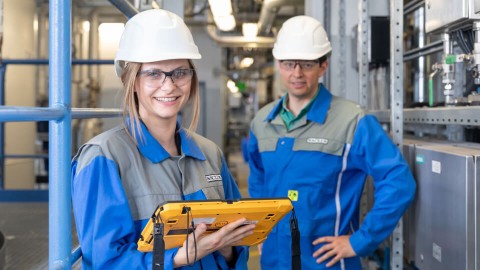VINNAPAS® 550 ED

VINNAPAS® 550 ED is a multi-purpose construction dispersion, specifically suited for cement admixtures, the formulation of two-component cementitious waterproofing membranes as well as the production of primers. The dispersion is based on a very flexible copolymer of vinylacetate and ethylene and belongs to the product class VINNAPAS® ED which means that it enhances adhesion and flexibility of mortars.
Properties
- VINNAPAS® 550 ED is an aqueous dispersion of vinyl acetate and ethylene copolymer with a 53% solids content.
- The dispersion is produced without the use of plasticizers.
- VINNAPAS® 550 ED is particulary suited for modifying mineral mortars. It improves the adhesion to inorganic and organic substrates, as well as abrasion resistance und flexural strength.
Data sheets
Two-component waterproofing membranes, primers & cement admixes are the most important applications for VINNAPAS® 550 ED. In theses applications VINNAPAS® 550 ED improves adhesion, abrasion resistance and flexural strength. For enhanced compressive and flexural strength, we recommend adding a suitable defoaming agent or modifying the dry component with a powder defoamer.
For further information regarding applications of VINNAPAS® 550 ED, refer to the section "application". Please discuss additional applications with your WACKER customer representative.
Processing:
VINNAPAS® 550 ED can be blended with most VINNAPAS® dispersions and many other aqueous polymer dispersions in any ratio. When blending, it is important to adjust the pH of both dispersions which are to be blended in a pH range in which both dispersions are stable. Storage tests should be carried out to check the compatibility of the mixture.
If the product is used in applications other than those mentioned, the choice, processing and use of it is the sole responsibility of the purchaser. All legal and other regulations must be complied with.
Slight color variations of the polymer granulate may occure without impairing the product's functionality.
Packaging
Non-returnable PE drums of 150 kg capacity (standard dispatch quantity: only fully-loaded pallets à 750 kg), non-returnable containers of 1 t capacity and road tankers.
Storage
Sales and support
Allentown, PA 18106-9346
United States
+1 517 264-4088 (Fax)
How can we help you?
- Do you need help in choosing a product or do you require technical support? If so, please contact our experts.


